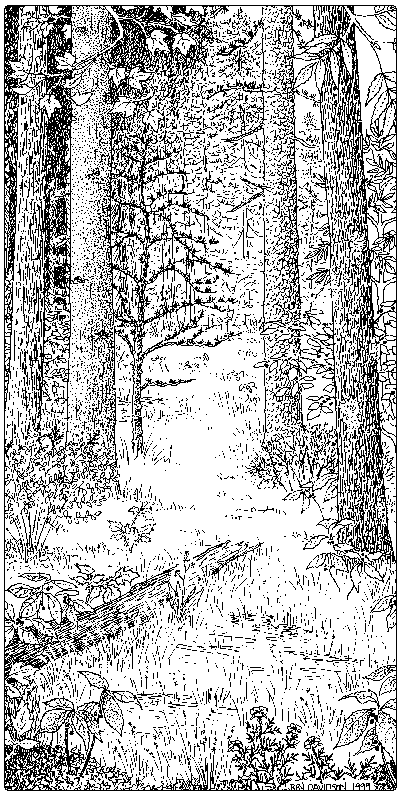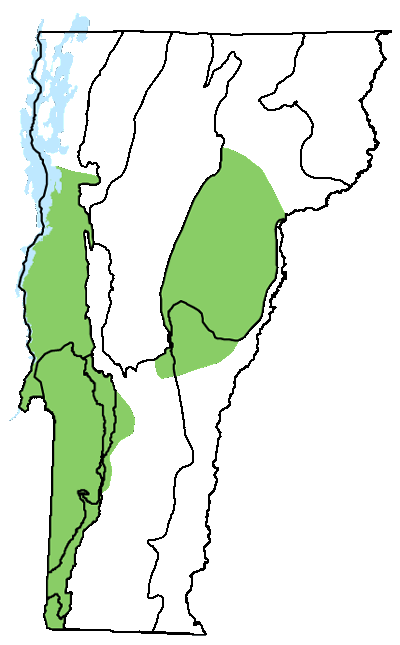Ecology and Physical Setting 
Open canopies, thick mats of sedges, and distinctive mosses make Calcareous Red Maple-Tamarack Swamps especially enchanting. This is a rare forested wetland type associated with calcium-rich groundwater seepage. This community occurs along the margins of stream valleys and in poorly drained depressions, often at stream headwaters. In both settings, groundwater seepage is common. The organic soils vary from peat to muck and are permanently saturated, leading to substantial accumulations. Some of these swamps have relatively flat surfaces, while others have more developed hummocks and hollows.
This community is found mostly in warmer regions of the state with calcium-rich bedrock such as limestone, dolostone, and marble. Although calcareous bedrock occurs in the cooler regions of the state as well, most of the seepage swamps in these areas are Northern White Cedar Swamps, Hemlock-Balsam Fir-Black Ash Seepage Swamps, or Red Maple-Black Ash Seepage Swamps.
When they occur in headwater basins, Calcareous Red Maple-Tamarack Swamps may be the only community present. In streamside valley settings, examples of this community type are often part of larger wetland complexes and are commonly associated with fens, sometimes intergrading with these open peatlands. Calcareous Red Maple-Tamarack Swamps may also grade into Northern White Cedar Swamps in areas of the state where both communities occur. Tamarack is very shade intolerant and seldom persists in closed canopy swamps unless there are regular disturbances that create canopy gaps.
Vegetation
Sometimes called wooded fens, these swamps have a canopy that varies from open woodland to nearly closed. This can be an abrupt change from closed canopy to small fen-like openings, or it can be a more gradual transition from closed canopy to open peatland. Red maple and tamarack are the dominant trees in most examples of this community. Other trees that may be present in the canopy include black ash, yellow birch, red spruce, hemlock, and white pine. Characteristic shrubs that reflect the calcium-rich groundwater include alder-leaved buckthorn, shrubby cinquefoil, hoary willow, red-osier dogwood, and poison sumac. Other shrubs that can be present in varying abundance include highbush blueberry, mountain holly, winterberry holly, black chokeberry, and maleberry. Regeneration of the tree species can also account for considerable low woody cover.

cones and frost-nipped needles.
The herbaceous layer is typically rich in species, a feature common to many calcareous wetland types. Characteristic species that are indicative of these calcium-rich conditions include yellow sedge, inland sedge, bristle-stalked sedge, water avens, rough-leaved goldenrod, swamp saxifrage, showy lady’s slipper, and bog-candles. Cinnamon fern, sensitive fern, marsh fern, and crested wood fern may be locally abundant. Bryophyte cover can be as high as 75 percent, and includes several species that are characteristic of fens, especially Calliergonella cuspidata, Sphagnum warnstorfii, and the rare Meesia triquetra. Shaggy moss, a characteristic species of cedar swamps, is also present in this community. Several species of sphagnum moss may dominate low hummocks. The distinctive Calliergon giganteum occurs on pool margins in several swamps.
Wildlife Habitat
Several species of salamanders may be found in Calcareous Red Maple-Tamarack Swamps. The northern dusky salamander and northern two-lined salamander both thrive in the groundwater seeps and in the associated cool-water streams. Wood frogs may breed in larger pools. Four-toed salamanders are closely tied to sphagnum moss and swamps. The females lay eggs singly on the undersides of moss leaves and branches, an inch or more into the moss mat. Blue-spotted salamanders are characteristic of swamps, primarily of the Champlain Valley. Breeding birds include veery, northern waterthrush, Canada warbler, and red-shouldered hawk. Wood ducks may also breed in examples of these swamps that are near open water.
Several rare butterflies may be found in Calcareous Red Maple-Tamarack Swamps. The caterpillars of spicebush swallowtail feed on spicebush, an occasional shrub of these enriched swamps. Lake sedge, and several other sedges, are host plants for the Appalachian brown, a small butterfly found in Vermont only in the Champlain and Vermont Valleys. The Dion skipper is found only in sedgy, calcareous wetlands, almost entirely west of the Green Mountains.
Related Communities
- Red Maple-Black Ash Seepage Swamp is fed by groundwater but is not necessarily associated with calcareous bedrock. The canopy is more closed, without fen-like openings, and is dominated by red maple and black ash. Hummocks and hollows are more pronounced.
- Intermediate and Rich Fens are similar in species composition to Calcareous Red Maple-Tamarack Swamps and also receive calcium-rich groundwater seepage, but they are open peatlands with less than 25 percent tree cover.
Conservation Status and Management Considerations
A few examples of this rare wetland natural community are found on protected lands, but other examples are unprotected. In order to maintain the quality and quantity of calcium-rich groundwater reaching these swamps, it is necessary to protect both the immediate surface watershed and the area of groundwater recharge. It can be difficult, however, to identify the area of groundwater recharge without intensive study. The best course is to maintain a large area of intact natural land around each of these swamps. Creation of impervious surfaces or repeated heavy logging in the watershed could have negative effects on this rare community type. Logging within these swamps is not recommended.
Distribution/Abundance 
This is a rare natural community in Vermont. Closely related communities are found throughout southern New England and New York, and south to Pennsylvania and New Jersey.
Characteristic Plants
Trees
Abundant Species
Red maple – Acer rubrum
Tamarack – Larix laricina
Occasional to Locally Abundant Species
Black ash – Fraxinus nigra
Yellow birch – Betula alleghaniensis
Red spruce – Picea rubens
Eastern hemlock – Tsuga canadensis
White pine – Pinus strobus
Shrubs
Occasional to Locally Abundant Species
Alder-leaved buckthorn – Rhamnus alnifolia
Shrubby cinquefoil – Dasiphora fruticosa
Hoary willow – Salix candida
Red-osier dogwood – Cornus sericea
Poison sumac – Toxicodendron vernix
Highbush blueberry – Vaccinium corymbosum
Mountain holly – Ilex mucronata
Winterberry holly – Ilex verticillata
Maleberry – Lyonia ligustrina
Black chokeberry – Aronia melanocarpa
Spicebush – Lindera benzoin
Herbs
Abundant Species
Yellow sedge – Carex flava
Inland sedge – Carex interior
Bristle-stalked sedge – Carex leptalea
Occasional to Locally Abundant Species
Water avens – Geum rivale
Rough-leaved goldenrod – Solidago patula
Swamp saxifrage – Micranthes pensylvanica
Blue flag – Iris versicolor
Bog-candles – Platanthera dilatata
Tall meadow rue – Thalictrum pubescens
Lake sedge – Carex lacustris
Cinnamon fern – Osmundastrum cinnamomeum
Sensitive fern – Onoclea sensibilis
Marsh fern – Thelypteris palustris
Crested wood fern – Dryopteris cristata
Marsh marigold – Caltha palustris
Golden ragwort – Packera aurea
Wild strawberry – Fragaria virginiana
Dwarf raspberry – Rubus pubescens
Single-spike muhlenbergia – Muhlenbergia glomerata
Bryophytes
Moss – Calliergonella cuspidata
Moss – Calliergon cordifolium
Moss – Calliergon giganteum
Moss – Sphagnum warnstorfii
Moss – Tomenthypnum nitens
Shaggy moss – Rhytidiadelphus triquetrus
Starry moss – Campylium stellatum
Common fern moss – Thuidium delicatulum
Moss – Bryum pseudotriquetrum
Rare and Uncommon Plants
Hoary willow – Salix candida
Showy lady’s slipper – Cypripedium reginae
Bog wintergreen – Pyrola asarifolia
Mountain fly honeysuckle – Lonicera villosa
Small yellow lady’s slipper – Cypripedium parviflorum var. makasin
Bog bedstraw – Galium labradoricum
Moss – Tomenthypnum falcifoium
Moss – Meesia triquetra
Moss – Helodium blandowii
Associated Animals
Northern dusky salamander – Desmognathus fuscus
Northern two-lined salamander – Eurycea bislineata
Gray treefrog – Hyla versicolor
American beaver – Castor canadensis
Veery – Catharus fuscescens
Red-eyed vireo – Vireo olivaceus
Northern waterthrush – Parkesia noveboracensis
Canada warbler – Cardellina canadensis
Eastern red damsel – Amphiagrion saucium
Rare and Uncommon Animals
Blue-spotted salamander – Ambystoma laterale
Four-toed salamander – Hemidactylium scutatum
Wood turtle – Glyptemys insculpta
Spotted turtle – Clemmys guttata
Red-shouldered hawk – Buteo lineatus
Spicebush swallowtail – Papilio troilus
Appalachian brown – Lethe appalachia
Dion skipper – Euphyes dion
Places to Visit
Les Newell Wildlife Management Area, Barnard, Vermont Fish and Wildlife Department (VFWD)
Otter Creek Wildlife Management Area, Mount Tabor, VFWD
Tinmouth Channel Wildlife Management Area, Tinmouth, VFWD
Chickering Bog Natural Area, Calais, The Nature Conservancy
